News
Two killed, as bad weather causes blackouts, landslides and property damage
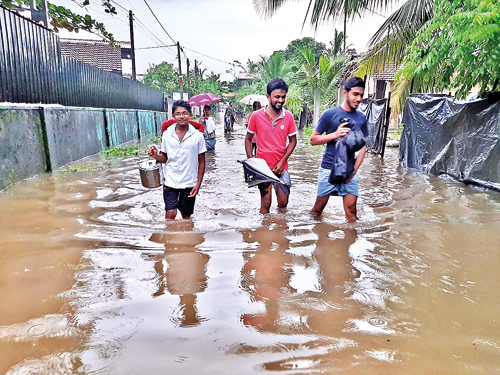
102 people were affected in Galle. Pic by D.G Sugathapala
At least two people were killed, 300 houses damaged and more than 40,000 households left without electricity supplies as monsoon rains affected several parts of the country this week, officials said.
The two deaths were reported from the Kegalle district. A 48-year-old man died after being swept away by the currents in the Imbuldeniya area and a 65-year-old woman was killed in the Waldeniya area when her house was damaged in a landslide.
The bad weather also caused power breakdowns in several areas.
According to the Power and Energy Ministry, 5,600 households in Bandarawela, 3,000 in Ratanpura, 5,800 in Matara, 13,000 in Gampaha, 12,000 in Anuradhapura, 4,200 in Trincomalee and 780 in Nuwara Eliya were affected by the sudden power breakdown.
A ministry spokesman said steps were being taken to restore the supply.
In the worst hit district of Kegalle, 378 families were affected in the Galigamuwa division with 272 houses being damaged, while in the Kegalle, division, 106 families were affected and 65 houses were damaged, according to District Secretary Mahinda Weerasooriya.
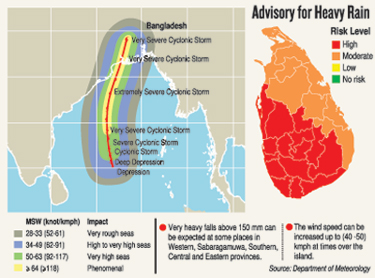 He said earth-slips were reported on the Kegalle-Polgahawela main road and Kegalle-Siyambalapitiya main road.
He said earth-slips were reported on the Kegalle-Polgahawela main road and Kegalle-Siyambalapitiya main road.
Galle District Secretary Somarathna Vidhanapathirana said 31 houses in 19 Grama Niladhari divisions were damaged with one of them suffering extensive damage due to lightning. The number of affected people reported from the district was 102. Among them were two people who suffered injuries when their houses were damaged.
Security forces have been deployed on rescue missions in areas such as Thawalama, Neluwa and Nagoda to carry out rescue mission in the event of floods.
In Akmeemana and Baddegama, residents have been advised to move to safe areas in view of possible landslides.
The Disaster Management Centre (DMC) yesterday issued flood warning to residents living in areas along the Kelani river, Maha Oya and Attanagalu Oya and urged them to move to safe areas.
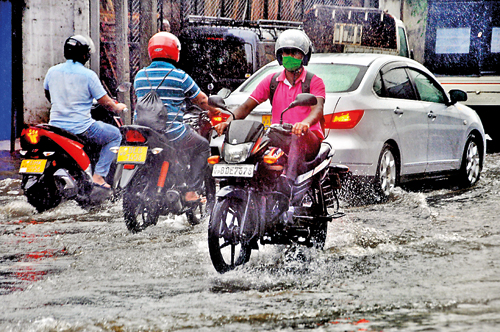 “The Kegalle district was the worst affected. Heavy rains and landslides have caused damage to several houses, although none of the affected people has been directed to relief camps so far,” DMC Deputy Director Pradeep Kodippili said.
“The Kegalle district was the worst affected. Heavy rains and landslides have caused damage to several houses, although none of the affected people has been directed to relief camps so far,” DMC Deputy Director Pradeep Kodippili said.
He said they were ready with a special rescue programme in keeping with the COVID-19 health guidelines in the event of an emergency.
The Meteorological Department said yesterday that the country’s south-western parts would receive heavy rains of above 200mm in the next three to four days.
Showers or thunder showers can also be expected in the Uva and North-Central provinces with isolated heavy rainfalls of above 100mm.
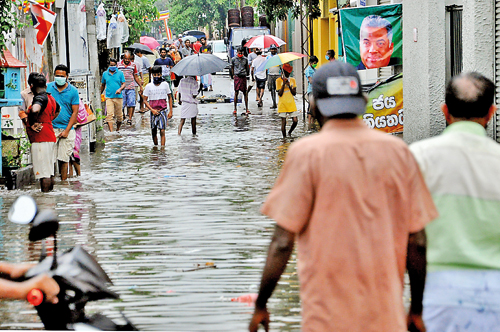 According to the rainfall recorded by the Automated Rain Gauge systems, from 8.30 a.m. on Friday to 3 a.m. yesterday, Galigamuwa in the Kegalle district received the highest rainfall of 212mm, while the Sirikandura and Hegoda areas in the Galle district reported a rainfall of 202mm and 191mm respectively. Kiriella in the Ratnapura district reported 151mm of rainfall.
According to the rainfall recorded by the Automated Rain Gauge systems, from 8.30 a.m. on Friday to 3 a.m. yesterday, Galigamuwa in the Kegalle district received the highest rainfall of 212mm, while the Sirikandura and Hegoda areas in the Galle district reported a rainfall of 202mm and 191mm respectively. Kiriella in the Ratnapura district reported 151mm of rainfall.
“The low pressure area over southeast Bay of Bengal is likely to develop into a depression over the same region and further intensify into a severe cyclonic storm with heavy thunder showers in several areas on its path,” a duty meteorologist said.
The National Building Research Organisation (NBRO) issued warnings of possible landslides, slope failures and rock falls in the Galle, Matale, Ratnapura, Kalutara, Matara, Colombo, Kegalle, Kurunegala and Kandy districts.
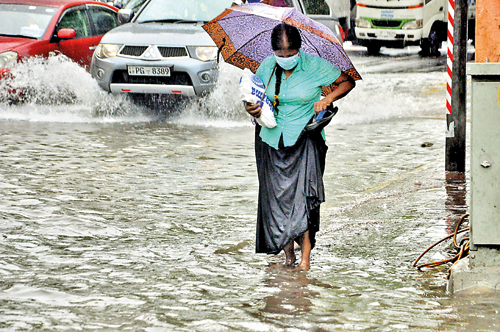
Several places in Colombo were flooded after a heavy downpour on Friday. Pix by Priyantha Wickramaarachchi
Evacuation warnings have been issued to residents of Baddegama, Pelmadulla, Ratnapura, Elapatha, Nivithigala, Kalawana, Kiriella, Kegalle, Dehiowita and Polgahawela divisional secretariat areas.
Meanwhile, the Power and Energy Ministry said the daily electricity demand which averaged around 32 to 34 gigawatt hours last week increased to almost 40 gigawatt hours on Friday.
The Ministry’s Development Director Sulakshana Jayawardena said, “Generally during February, March and April due to the dry weather conditions in the country the daily demand rises to almost 50 gigawatt hours. However, with many factories remaining closed due to the COVID-19 pandemic, the demand had still not reached 50 gwh level.”
In the main six reservoirs, the water capacity stood at an average of 50.2 per cent on Friday, he said. The Castlereagh reservoir was 46.3 percent full; Maussakelle 37.7 percent; Kotmale 46.9 percent; Victoria 53.8 percent; Randenigala 55.8 percent and Samanalawewa 62.3 percent.


